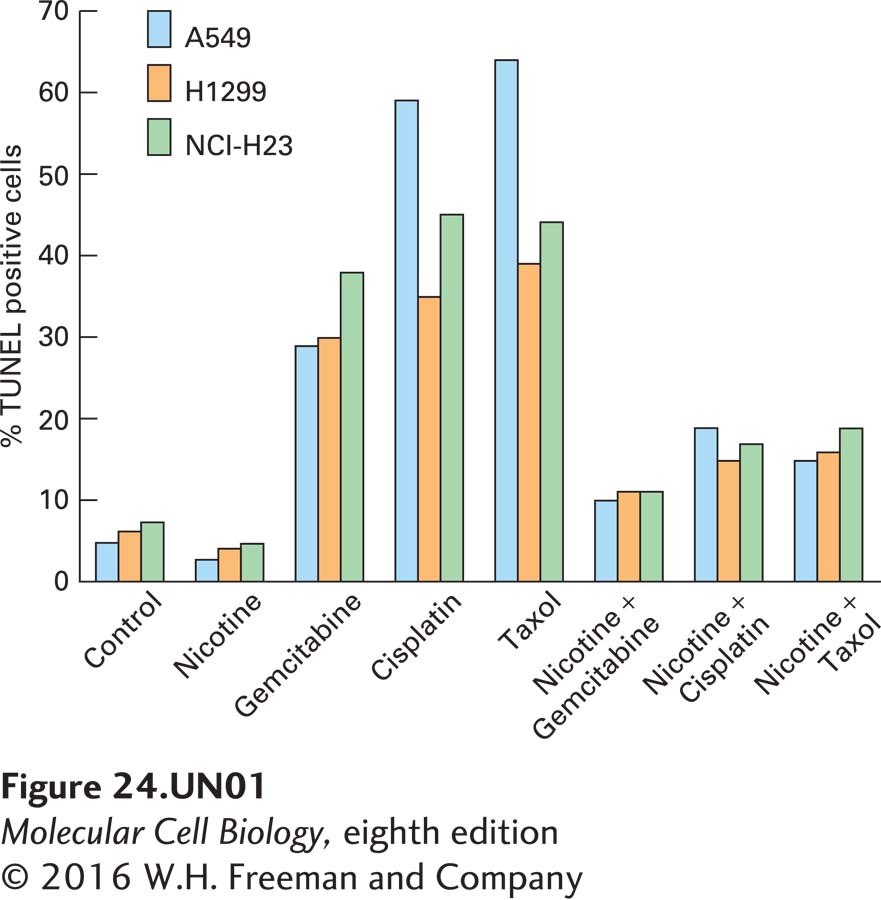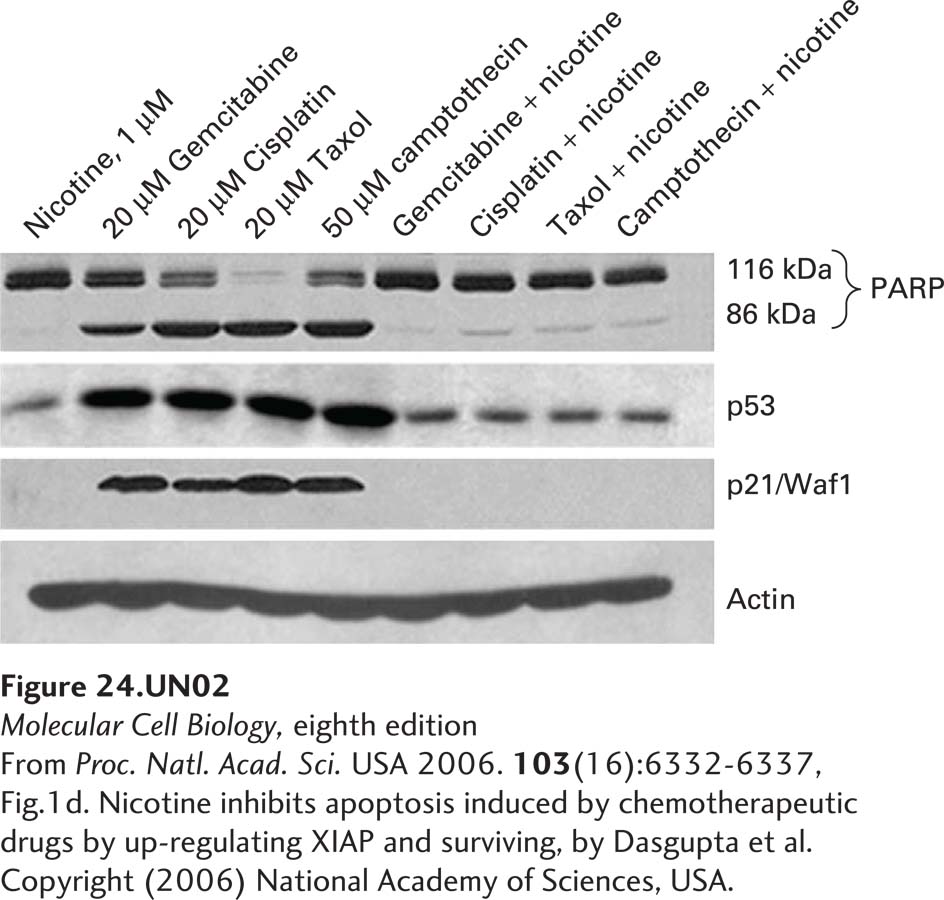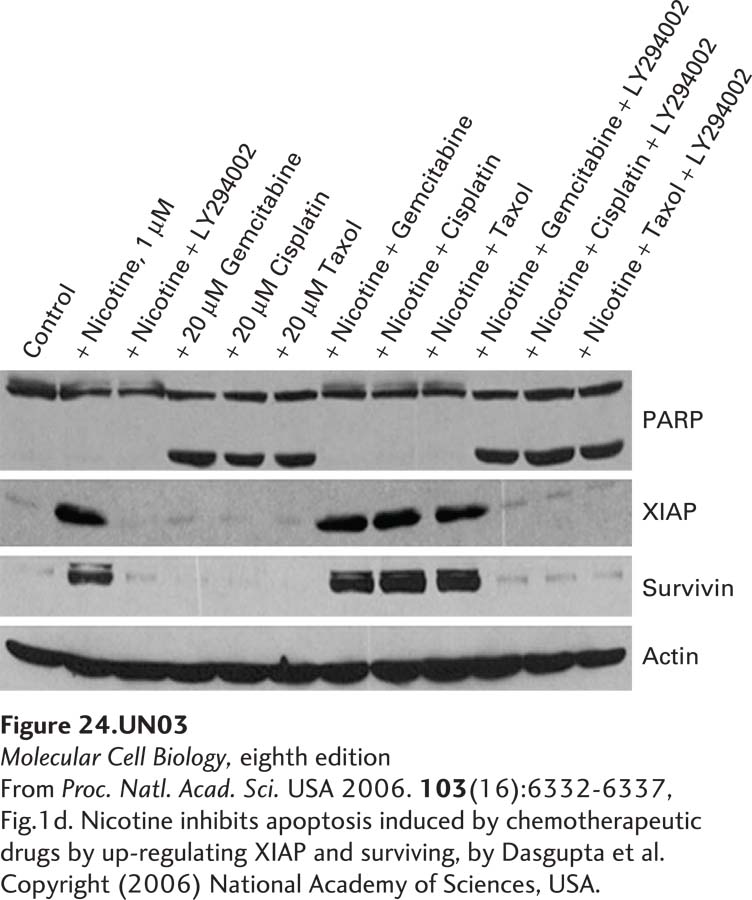
Chapter 24. Nicotine and Chemotherapy
Introduction

Analyze the Data 24-1: Nicotine and Chemotherapy
Cigarette smoking is a major risk factor in the development of non-small cell lung cancer (NSCLC), which accounts for 80 percent of all lung cancers. NSCLC is characterized by poor prognosis and resistance to chemotherapy. To understand if nicotine affects this resistance, lung cancer cell lines were treated with the chemotherapeutic drugs gemcitabine, cisplatin, and Taxol in the presence and absence of nicotine (see P. Dasgupta et al., 2006, Proc. Natl. Acad. Sci. USA 103:6332–6337).
a. Three different NSCLC cell lines, A549, NCI-H23, and H1299, were examined by the TUNEL assay, which detects cells that are undergoing apoptosis. The cells were either untreated or treated with one of the three chemotherapeutic drugs in the presence or absence of nicotine. The following data were obtained. Why are these chemotherapeutic drugs potentially useful for the treatment of lung cancer, and how does nicotine affect their potential usefulness?

Each of the three drugs causes the NSCLC cells to undergo apoptosis at a significant level. Thus, the rationale for using these drugs is that they would induce the death of the cancer cells. However, nicotine appears to interfere with this induction of apoptosis, perhaps explaining why NSCLC is resistant to chemotherapy.
b. A549 cells were incubated with the drugs as in part (a) and an additional chemotherapeutic drug, camptothecin, in the presence or absence of nicotine. The cells were lysed, extracts were run on SDS gels, and then the gels were blotted and probed with antibodies against the indicated proteins. PARP is a protein that is cleaved during apoptosis. What can you deduce from these data about the effects of nicotine? What is the purpose of assessing the levels of p53, p21, and actin?

PARP is cleaved upon treatment with the four chemotherapeutic drugs but is not cleaved when nicotine is also present. Because PARP is cleaved upon apoptosis, these data suggest, as in (a), that the chemotherapeutic drugs induced apoptosis, but that this apoptosis does not occur if nicotine is present. p53 and p21 both appear to be produced more, or stabilized, in cells treated with the chemotherapeutic drugs. Each of these proteins would contribute to arresting the cells in G1 or G2, thereby keeping them from proliferating. Such an increase in the amounts of these two proteins does not occur when nicotine is also present. Thus, nicotine circumvents the ability of the chemotherapeutic drugs to induce the cells to arrest in G1 or G2 (which then likely leads to apoptosis). The fact that actin levels are unaffected by the various treatments indicates that the chemotherapeutic drugs specifically affect the cell cycle and nicotine interferes with this effect. Moreover, the actin data serve to ensure that the gel lanes have been loaded equally and that the differences observed in the amount of other proteins from lane to lane is biologically relevant and not a loading artifact.
c. Survivin and XIAP are both members of the inhibitor-of-apoptosis (IAP) family, proteins that protect cells against apoptosis. A549 cells were treated with the chemotherapeutic drugs in the presence or absence of nicotine and in the presence or absence of LY294002, an inhibitor of PI-3 kinase (see Chapter 16). The levels of PARP, XIAP, survivin, and actin were assessed, as shown in the Western blots below. The graph shows the results of a TUNEL assay in which A549 cells were transfected with the indicated siRNAs. “None” indicates the amount of cell death with no transfected RNA. Control siRNAs 1 and 2 are irrelevant RNAs added to control for nonspecific effects of having an interfering RNA entering the cells. What do these studies suggest about the mechanism of nicotine action?


Nicotine causes the levels of XIAP and Survivin proteins to increase (see the blot above), and this increase is required for the survival of the cells in the presence of the chemotherapeutic drugs (the graph below shows that treatment with siRNA to prevent XIAP and Survivin increases causes cells to undergo gemcitabine-induced apoptosis even when nicotine is present). The protein-level increases appear to be mediated by the PI-3 kinase pathway because inhibition of this pathway with LY294002 eliminates the protein increases and causes apoptosis, as assessed by PARP cleavage. A likely signal-ing pathway is that nicotine binds to a cell surface receptor that activates PI-3 kinase which, in turn, leads to increased Survivin and XIAP, both of which help protect the cells against the apoptosis induced by chemotherapeutic drugs.
d. Can you provide a biological explanation for why the prognosis is poorer for patients who smoke during chemotherapy compared with those who quit smoking prior to it?
The patients who continue to smoke will inhale nicotine that will bind to receptors and thus activate PI-3K. PI-3K activity will result in increased Survivin and XIAP, which will oppose the action of the chemotherapeutic drugs. Normally, the drugs cause the cells to undergo apoptosis, thus destroying the tumor as well as some other cells. Thus, chemotherapy will be essentially without benefit in individuals where nicotine prevents tumor cell death.
Activity results are being submitted...